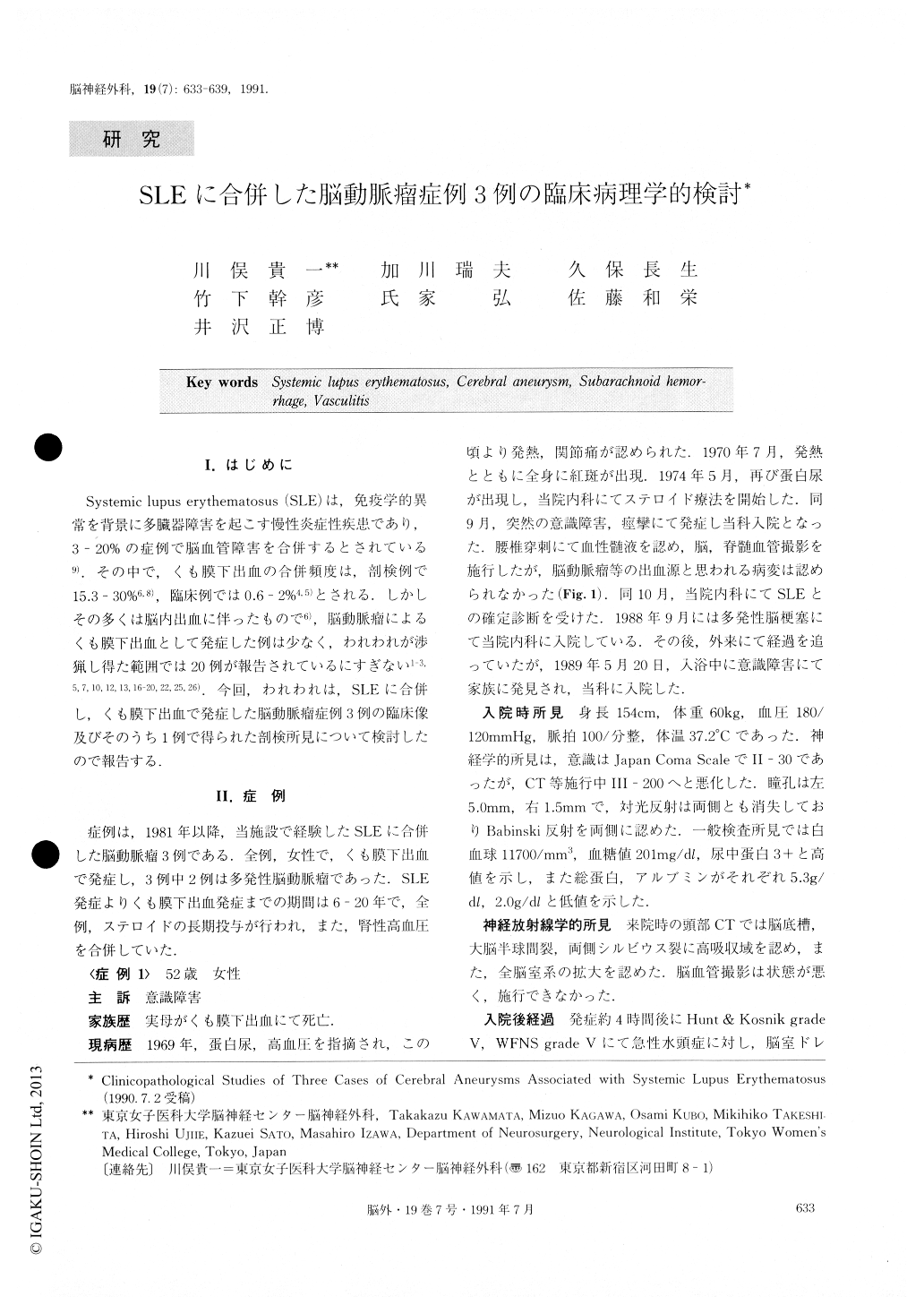Japanese
English
- 有料閲覧
- Abstract 文献概要
- 1ページ目 Look Inside
I.はじめに
Systemic lupus erythematosus(SLE)は,免疫学的異常を背景に多臓器障害を起こす慢性炎症性疾患であり,3-20%の症例で脳血管障害を合併するとされている9).その中で,くも膜下出血の合併頻度は,剖検例で15.3-30%6,8),臨床例では0.6-2%4,5)とされる.しかしその多くは脳内出血に伴ったもので6),脳動脈瘤によるくも膜下出血として発症した例は少なく,われわれが渉猟し得た範囲では20例が報告されているにすぎない1-3,5,7,10,12,13,16-20,22,25,26).今回,われわれは,SLEに合併し,くも膜下出血で発症した脳動脈瘤症例3例の臨床像及びそのうち1例で得られた剖検所見について検討したので報告する.
Abstract
We report three cases of ruptured cerebral aneurysms associated with systemic lupus erythematosus (SEE). A 52-year-old woman (case 1) with a fifteen-year history of systemic lupus erythematosus suddenly lost con-sciousness. She was admitted in a state of deep coma. A computed tomography (CT) scan revealed acute hydrocephalus and diffuse suharachnoid hemorrhage inthe basal, interhemispheric and bilateral Sylvian cist-erns. Fifteen years prior to this admission, cerebral angiograms demonstrated no cerebral aneurysm. She underwent ventricular drainage immediately. Postoper-atively, her condition did not improve, and she died on the 18th day. During the autopsy, two saccular cerebral aneurysms were found : one aneurysm was at the right middle cerebral artery bifurcation, and another one was on the anterior communicating artery, which had dis-ruption of the internal elastic lamina and medial smooth muscle, and infiltration of inflammatory cells. In the major cerebral arteries, for example the bilateral inter-nal carotid arteries, disruption or dissection of the inter-nal elastic lamina, intimal fibrosis and transmural infil-tration of inflammatory cells were observed.
The second patient, a 36-year-old woman with a six-year history of SEE, was admitted to our hospital with sudden severe headache. A CT scan showed subarach-noid hemorrhage, and cerebral angiograms diclosed saccular cerebral aneurysms on the anterior communi-cating artery and the left superior cerebellar artery, and a fusiform one on the left posterior cerebral artery. Surgery was not recommended because of her multiple medical problems. Her consciousness improved gradual-ly over 2 months. She was transfered to the department of internal medicine for treatment of renal failure. The third patient, a 34-year-old woman with a seven-year history of SLE, was found to have a ruptured cerebral aneurysm at the basilar artery bifurcation. She underwent clipping. She was transfered to another hos-pital 3 months after the admission.
Review of the literature reveals 24 previous reports of cases of cerebral aneurysms associated with SLE. Most of these aneurysms are attributed to lupus vascu-litis. In SLE, perivascular infiltration of lymphocytes is noted frequently, but true vasculitis of cerebral vessels is relatively rare. As far as the cerebral vessels are con-cerned, destructive changes in the walls are seen com-monly in small cerebral vessels, however, these lesions are uncommon in large vessels. In case 1, internal elas-tic lamina disruption and infiltration of inflammatory cells were found at the aneurysmal necks. In addition to these findings, we observed internal elastic lamina disruption or dissection, transmural infiltration of in-flammatory cells and intimal fibrosis in major cerebral arteries away from the cerebral aneurysms. Based on these histopathological findings and the angiograms taken 15 years previously, we suggest that local weak-ness of cerebral vascular walls and cerebral vasculitis were responsible for the secondary aneurysmal forma-tion.

Copyright © 1991, Igaku-Shoin Ltd. All rights reserved.


